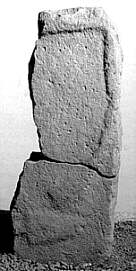|
|
 |
 |
 |
The monuments belonging to group A are mostly intact while those of group B were found broken mainly in the head and the breasts. This fact, which cannot be explained in terms of natural or unintentional causes only, suggests that an intentional iconoclasm was carried out in the past against the stelae of group B, in some cases with particular intensity.
 |
 |
 |
The Prehistoric Iconoclasm
Since the intentionally damaged monuments mainly belong to one of the groups and on the basis of the excavation data of Minucciano III, it can be hypothesized that the first iconoclasm occurred during the early Iron Age (about in the beginning of the first millennium b.C.), probably caused by a deep and violent cultural and social upsetting.
In fact the new dominant classes tryed to destroy the monuments which celebrated the power of the old ruling people, wheater the statues had civil or religious meaning.
 |
 |
The Christian Iconoclasm
The second iconoclastic activity occurred with certainty during Middle Age. Despite the territory of Lunigiana was early christened, the removal of the pagan culture and tradictions continued until the last centuries of the first millennium a.C.
A medieval document reported a decree of a local bishop who invited people to destroy the idols and to build churches over those pagan cult sites. Obviously the statues were retained as representations of pagan gods.
SORANO III, Filattiera (MS) The condition in which the stela of Sorano III was found seems to be an effect of the above reported decree. In fact, it was found just below the main church of the town and broken into three or four fragments, despite its large thickness.
A futher evidence of the christian iconoclasm comes from a stone memorial tablet localized within the Church of S.George of Filattiera. It deals with a Longobard man who lived in the VIII century a.C.: among his merits, the tablet also includes the fact that idola fregit, i.e. he broke idols!


